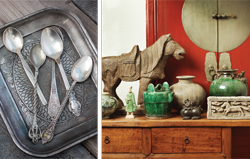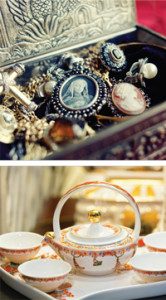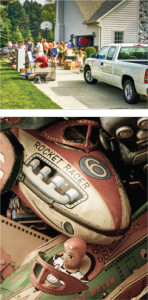Let It Go | Finding a New Home for Old Belongings

Empty-nesters, retirees or those simply looking to downsize from a large house to a smaller residence already have a lot to think through. Coordinating a move is challenging at any stage, but one of the more daunting aspects of downsizing later in life is finding a new home for a large volume of items and possessions you still hold dear, but don’t necessarily want or need to take to your new abode. Currently, there is a strong trend toward minimalism—including limiting possessions to maintain cleaner and less cluttered spaces. This is especially true for younger generations. This means that up to three generations could be looking to pare down possessions at the same time.
People in their 90s who might be shifting from living independently to assisted living apartments may be trying to hand down items to children in their 60s, who themselves might be empty-nesters looking for a smaller home. And those 60-yearolds might have kids in their 30s who are living more simply, or who may be trying to keep things Spartan in a small house or apartment. In addition, younger generations like the concept of mobility, which keeps them from acquiring more items than they can easily move.
 While past generations expected—and looked forward to— inheriting family heirlooms, many empty-nesters and retirees are finding that their offers of antique oak furniture, sets of formal china, crystal glasses, or framed paintings are being politely declined. In addition, possession-purging methods— like the popular KonMari method—advocate a shocking lack of sentimentality, even directing followers to throw away photos. So, the trend can be brutal to people who appreciate items from the past.
While past generations expected—and looked forward to— inheriting family heirlooms, many empty-nesters and retirees are finding that their offers of antique oak furniture, sets of formal china, crystal glasses, or framed paintings are being politely declined. In addition, possession-purging methods— like the popular KonMari method—advocate a shocking lack of sentimentality, even directing followers to throw away photos. So, the trend can be brutal to people who appreciate items from the past.
In addition to bruising some feelings, this leaves downsizers scrambling to find new, and hopefully grateful, owners for these treasured items.
Use it—don’t lose it
First, before you gift anything to anyone, ask yourself if you really want to give it away. If you were thinking of giving your fine china and beautiful crystal wine glasses away while taking just your casual plates and glasses to your new home, consider doing the opposite! Enjoy using your heirloom items, and pack up your everyday stuff to give away.
Instead of keeping your lovely fancy serving dishes for holidays, break them out all the time. Have you always stored collections of treasured items in boxes? Maybe you should use them for decor in your new place so you can see them every day. Select the best of your furniture for the move, and try to find a home for the less loved items.
Reassess what you have and what you use, and see if you can mix things up to take advantage of your wonderful heirloom items and truly enjoy them yourself.
 Family first—but not last
Family first—but not last
To start giving away your treasures to people you love, it’s probably best to begin with your immediate family—especially if you know they have admired certain items, or collect certain things. You also never know who has a need for, or emotional attachment to, your things until you ask. Let your children know what’s available, and see who might be open to accepting the gifts. You can also extend the offer to siblings, nieces, nephews and grandkids.
Once you’ve given first dibs to family, you can also extend to those people in your life who have become like family. If your best friend’s children are like second kids to you, maybe they would love to have some items to remind them that you’re like a second parent. Neighbors, your community from where you worship, and other close friends might also be candidates.
To help “market” your items, take photos and text them to your potential takers. Offer any interesting history you want passed along. A set of dishes might be more appealing if you can share the date and occasion they were purchased.
If your kids tell you they want certain items eventually, but don’t have the space for them now, consider renting low-cost space at a self-storage facility as a temporary fix.
People collect and treasure all sorts of things, and you never know what might be of value to them. This could include everything from furniture to jewelry to kitchen items. You may be surprised at what people enjoy. Whatever you yourself no longer need or want, it can’t hurt to offer.
On the flip side, if people decline, don’t take it personally. People are assessing the items based on personal style and space. Just because they decline to take your things, doesn’t mean it reflects on you.
Cashing in—options for selling
If you feel like your items have financial value, you may want to try and sell them. There are numerous ways to do this, but it’s a good idea to start as soon as you know you are moving—because the more time you have to sell, the more you might be able to get for them.
You can reach out to local auction houses, antique dealers and consignment shops to describe what you have available and see if they want to come to your home and give you an estimate.
The same rule applies here as with giving to family—don’t take anything personally. These kinds of stores can only accept what they can sell, and if trends are leaning away from certain items, they won’t be able to sell yours. For example, you may find an antique dealer clamoring to buy your midcentury modern furniture, but declining all of your older antiques that have been passed down for generations. That’s not them passing judgment on anyone’s taste—they just know what they can re-sell and what they can’t.
You can also take jewelry to local jewelers to see if they wish to purchase, or to see if they can do a quick appraisal to determine value, which might help you sell it elsewhere.
 Once you have exhausted local sources, you may want to try online options. Make sure you have good photos and a great description. Furniture and heavy items can be posted on Craigslist and local “for sale” Facebook pages, asking buyers to pick up themselves. Smaller pieces, like vintage toys, classic cameras, glassware, china (pretty much anything, really) can be posted for sale on eBay and Etsy—two of the more popular selling platforms. These sites involve setting up your online “store,” and you will have to ship items as well, but it might be worth it depending on what you have to sell. Vintage clothing can be pretty popular, especially anything from the 80s, which is a hot trend now. Poshmark is an excellent website that lets you create an online boutique, including easy shipping to buyers.
Once you have exhausted local sources, you may want to try online options. Make sure you have good photos and a great description. Furniture and heavy items can be posted on Craigslist and local “for sale” Facebook pages, asking buyers to pick up themselves. Smaller pieces, like vintage toys, classic cameras, glassware, china (pretty much anything, really) can be posted for sale on eBay and Etsy—two of the more popular selling platforms. These sites involve setting up your online “store,” and you will have to ship items as well, but it might be worth it depending on what you have to sell. Vintage clothing can be pretty popular, especially anything from the 80s, which is a hot trend now. Poshmark is an excellent website that lets you create an online boutique, including easy shipping to buyers.
Do a quick online search for whatever you are posting to see what similar items are selling for, just so you know market value. For example, you might not place any value on old toys, but vintage toys evoke nostalgia and can be surprisingly popular. On the flip side, if you see your items selling for a very low amount, or not selling at all, you can manage your expectations on what might not be of interest and relegate those items to the donation bin.
Craigslist, local Facebook pages and area Freecycle groups are also excellent options for giving items away, and are great for items that you can’t sell, but you also don’t feel like donating in bulk to charity. You get the satisfaction of giving your items to specific people who want them.
If digital isn’t your thing, and you don’t want to go to multiple local shops to gauge interest, you can also partner with companies or individuals to hold an estate sale. They usually charge a commission on sales, so they are motivated to sell your items. However, ask for references prior to hiring.
 The dos of donating
The dos of donating
For those items that you can’t sell or give to people you know, donation to charity is a great option. You can contact national organizations—like Goodwill, Habitat for Humanity’s ReStore and the Salvation Army—as well as local charity thrift stores to see if they can pick up in bulk, which is especially helpful for furniture and heavy items.
If you are culling in stages, you can bag or box up smaller items like clothing, books, kitchen items, and bric-a-brac and donate them to local stores as you go. Just check donation hours and days as drop-off times can vary, especially with local businesses.
Don’t forget to track your donations for tax purposes. Charities sometimes provide pricing lists with approximate value of donated items.
Maximizing memories
When it comes to very personal items—like old videos, photographs, letters and the like—you can opt to keep them, or digitize them. You can scan photographs and letters yourself, or hire companies that will do it for you, as well as have companies digitize old VHS tapes. This will preserve memories not just for you, but also for generations to come.
If you have other items you just can’t part with entirely but can’t take with you, consider taking photos, and then saying farewell.
 Calling in the professionals
Calling in the professionals
If you are feeling overwhelmed, as many people do, you can hire a professional to help navigate the logistics, as well as the emotional issues of parting with your belongings.
The National Association of Senior Move Managers (nasmm.org) is a trade organization supporting a growing network of experts who are helping older adults and their families with the daunting process of downsizing and moving to a new residence.
There are numerous ways to begin divesting your treasure trove of belongings—from gifting to loved ones, to giving them away to people who express their interest, to selling, to donating. You can go at it alone, or pay professionals to partner with you. With some planning and creativity, old belongings can definitely find new homes. You just need to explore all options and put a little effort into matching your items with future destinations. Ultimately, your goal is to enjoy your new space, surrounding yourself with just what you need, and nothing that you don’t.
TREND ALERT: SWEDISH “DEATH” CLEANING
On the heels of Marie Kondo’s “The Life-Changing Magic of Tidying Up” comes “The Gentle Art of Swedish Death Cleaning,” from Margareta Magnusson. Dubbed “a charming, practical, and unsentimental approach to putting a home in order,” the book extols the virtues of a particular kind of decluttering— döstädning (pronounced doh-stad-ning)comprised of dö meaning “death” and städning meaning “cleaning.” While you can purge belongings at any stage of life, this trend urges older people to begin to purge long before they downsize, with the idea that, when they pass away, they won’t leave a house full of stuff for their family to deal with. By prioritizing possessions based on the easiest to get rid of (old clothes you don’t want) to items you want to keep (letters, photos, mementos from kids) you can begin to part with items slowly, over time, so that when you depart, you haven’t burdened your kin with closets full of belongings. It also allows the older generation to choose what they keep and what items they give away (and to whom)—versus leaving it up to family, who may be overwhelmed doing it all at once. The author suggests giving away nicer items as meaningful heirlooms at holidays or birthdays, instead of buying something new as a gift. She also suggests making it clear what can be tossed after you pass—such as labeling a box of love letters for the bin, thereby relieving family of the guilt of keeping it.
Antique Dealers, auction houses, china, classic cameras, Consignment Shops, Craigslist, eBay, Empty-nesters, Etsy, Facebook, Freecycle groups, glassware, retirees, Spartan, The National Association of Senior Move Managers, Vintage clothing, vintage toys






